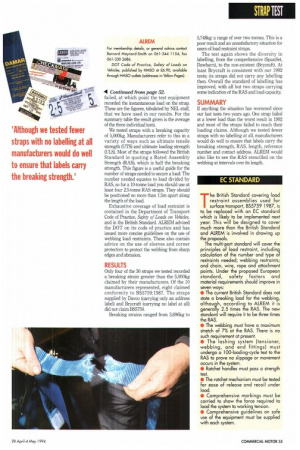EC STANDARD
Page 57

If you've noticed an error in this article please click here to report it so we can fix it.
The British Standard covering load restraint assemblies used for surface transport, B55759 1987, is to be replaced with an EC standard which is likely to be implemented next year. This will be designed to cover much more than the British Standard and ALREM is involved in drawing up the proposals. The multi-part standard will cover the principles of load restraint, including calculation of the number and type Of restraints needed; webbing restraints; and chain, wire, rope and attachment points. Under the proposed European standard, safety factors and material requirements should improve in seven ways:
• The current British Standard does not state a breaking load for the webbing, although, according to ALREM it is generally 2.5 times the RAS. The new standard will require it to be three times the RAS.
• The webbing must have a maximum stretch of 7% at the RAS. There is no such requirement at present. • The lashing system (tensioner, webbing, and end fittings) must undergo a 100-loading-cycle test to the RAS to prove no slippage or movement occurs in the system. • Ratchet handles must pass a strength test.
• The ratchet mechanism must be tested for ease of release and recoil under load.
• Comprehensive markings must be carried to show the force required to load the system to working tension. • Comprehensive guidelines on safe use of the equipment must be supplied with each system.
























































































































